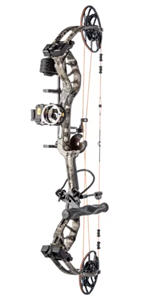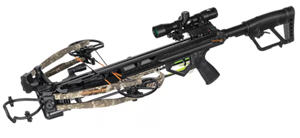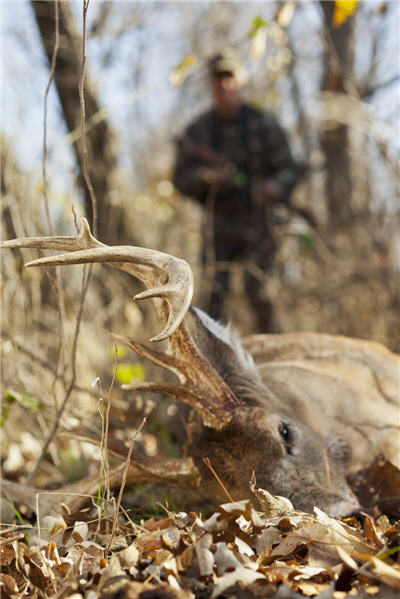
At some point in your deer hunting career you will shoot a deer that runs out of sight before it dies. The seriousness of the situation can range from the deer running into heavy cover 25 yards away and falling, to a marginally hit animal that’s in no danger of dying, but leads you on a long chase to make sure that’s what really happened.
The worst situation is a shot to non-vital organs from which the deer is sure to eventually die but leaves a minimal blood trail.

arrow can tell you a lot about your hit and how to
proceed in recovery.
Gain the Advantage in Recovering Every Deer You Shoot With These 12 Tips
1. Shoot Enough Gun or Bow: In shooting game, dead is dead and there’s no such thing as “overkill.” However, on the other side of the scale there are practical considerations of recoil or draw weight, accurate shooting, conserving meat, etc. You don’t need .375 H&H Mag. ammo or to draw 70 pounds to consistently, cleanly kill whitetail, but you should seek a rifle/bullet or bow/broadhead combo with the capability to consistently provide complete penetration.
While the hope is to drop an animal within sight, complete penetration is your backup plan if it doesn’t happen. Entrance wounds barely bleed. Exit wounds usually bleed profusely and provide an easily followed blood trail. When bow hunting, recovering a pass through arrow can tell you a great deal about your hit and how to proceed in recovery.

by SIK
Tip: The SIK Broadheads SK2 2-Blade Expandable Broadhead delivers leading field-point accuracy for bowhunting.

EKO RTH Compound Bow
Package
2. Mark Precise Spots: As you prepare to take your shot, fix in your mind the exact location of the animal. Carefully memorize several landmarks to give you a precise fix on where the deer was standing. This is especially critical at longer ranges. Do not take a shot unless you are confident you can go to the exact place the animal stood.
Tip: Bowhunters, the Bear Archery Divergent EKO RTH Compound Bow Package delivers deadly power and accuracy with a big performance that's easy on the wallet. The specialized EKO Cam system accurately fires arrows up to 338 fps, giving you more than enough power for whitetail, big game, and everything in between. With a wide 26"-30" draw length range makes it eady to find your perfect back wall. Easy handling - 4.1 lbs., 30" axle-to-axle
After the shot, the instant you’re certain you won’t get a follow-up, get your binoculars to your eyes and watch that animal. Mentally mark the last spot you saw it. That’s the point you’ll go to initially. If you can’t see the fallen animal from there, then mark the spot with surveyor’s tape or a glove and go back to the exact position of the animal when you shot. Study the area and your arrow if you can find it. You may be able to identify chunks of bone, lung tissue, blood color and texture, or digestive material to learn more about the hit.
3. Listen for the Deer: Equally important to watching the deer leave your sight is listening for some time afterward. You might hear it crashing through brush, fall over, or gasp its last. This is the best indicator you’ll have of the direction the deer went after leaving your view.
Tip: The Bear X Constrictor CDX Crossbow Package is perfect for hunting out of a treestand or a ground blind. This crossbow boasts a compact design that lets you easily maneuver in tight spaces to get the perfect shot!

4. Instant Replay: Many hunters video their hunts these days. If that’s you, make sure your camera guy (or gal) knows to stick with the animal after the shot until it falls or is out of sight. Hold and record that last point of contact for at least a five count after the animal disappears. This type of instant replay you can review again and again may be a tremendous aid in recovery.
5. Wait … or Not: On any hit animal that disappears from sight, the best course of action is to wait and give the animal time to bed down and die, or at least stove up. Pushing a wounded animal too soon spikes its adrenalin as it flees and ultimately makes recovery more difficult. However, you may need to follow right away. Rain or snow can eliminate a blood trail quickly. If you’re in an area where there’s significant hunting pressure, it may be wise to pursue immediately. (It falls upon you to know the traditions in the area you’re hunting.

woodsmanship skills together and recover
your deer.
Some places follow the first blood ethic, but in others the game belongs to the one who finishes it.) Increasingly, it’s problematic in many hunting areas to leave hit animals overnight because coyotes move quickly to ruin meat and trophies.
6. Don’t Be Afraid of the Dark: Darkness can actually be an aid in blood trailing deer. Old school is firing up a gas lantern. The light thrown by these lanterns makes the blood spots especially visible. The Primos BloodHunter Flashlight comes with special filters to make blood stand out, too. There are also products similar to those used by CSI-types that actually make blood glow in black light or in daylight.
7. Mark the Blood Physically and Digitally: As you follow, mark each spot of blood you find with a physical marker like surveyor’s tape or toilet paper. (When you’re done, be sure to recover markers that aren’t biodegradable.) With your handheld GPS unit, mark each third or fourth blood spot with a waypoint. That way if you lose the trail, it’s easy to look at the map and see the general direction of travel to continue the search.
8. Go Slow: In the excitement of shooting an animal, it’s easy to go plowing through the woods with enthusiasm to find it. Resist. Slow down and focus.
9. Look High and Low: A whitetail shoulder stands 30 to 34 inches above the ground. The top of the back might be has high as four feet. Look for blood smudges at those heights as well as for blood on the ground — and everywhere in between.
10. Use Your Optics: Binoculars are a critical blood trailing tool. Use them to scan ahead as far as you can see. Search every nook and cranny for out-of-place textures, colors, and lines. It could be your bedded, wounded deer.

11. Get Good Help: Getting the help of hunting friends who will be patient and thorough significantly boosts the odds of recovering a wounded deer. It’s key they don’t forge ahead of the tracker on the blood trail. Everyone must move slowly and patiently and carefully scan cover ahead.
If it’s legal where you’re hunting, seek the assistance of blood trailing dogs. Good dogs recover deer in seemingly impossible situations.
12. Never Give Up: The search for a gut shot animal can take days. You may not find the meat in condition to eat, but recovery and tagging is the responsibility you assumed when you elected to take the shot. A day or two into recovery you may be able to key on ravens or other scavengers that have found the dead or dying animal.
For tips on transporting your deer after the hunt, visit Transporting Game After the Hunt.
- 21652 views

